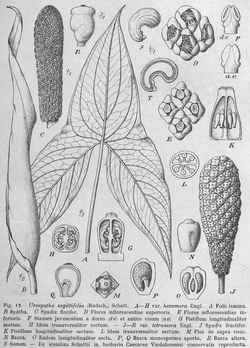| Urospatha | |
|---|---|
 | |
| Urospatha sagittifolia [1] | |
| Scientific classification | |
| Kingdom: | Plantae |
| Clade: | Tracheophytes |
| Clade: | Angiosperms |
| Clade: | Monocots |
| Order: | Alismatales |
| Family: | Araceae |
| Subfamily: | Lasioideae |
| Genus: | Urospatha Schott |
| Synonyms [2] | |
| |


Urospatha is a genus of flowering plants in the family Araceae that consists of 11 known species. They are found growing in South America and Central America [2] in swamps, wet savannahs, and brackish water. The leaves of the species in this genus are upward pointing and sagittate (arrow-shaped). The inflorescences are quite unique; the spathe is mottled and elongated with a spiral twist at the end. The seeds are distributed by water and have a texture similar to cork that allows them to float. They also quickly germinate in water. [3] [4] [5] [6]